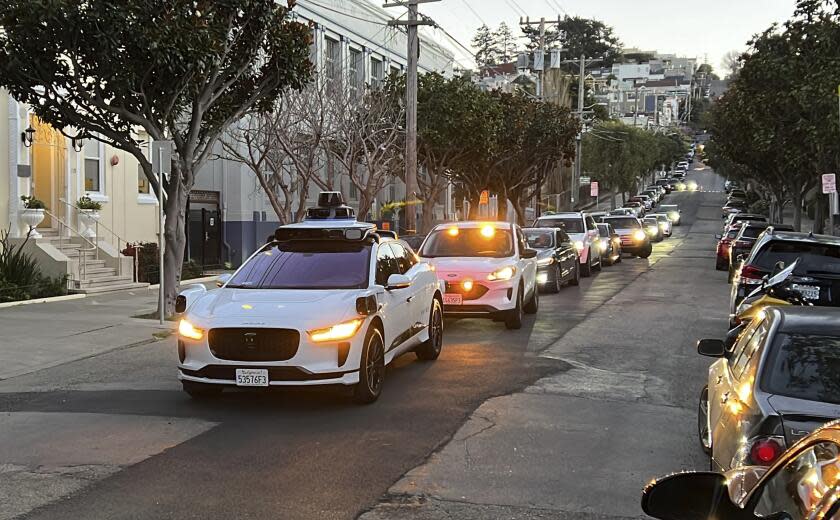Editorial: The robotaxi revolution is here. L.A., other cities need to be able to regulate driverless cars

It was not a great start to the robotaxi revolution. One day after California officials allowed a massive expansion of autonomous vehicle taxi service in San Francisco earlier this month, nearly a dozen self-driving Cruise vehicles came to a stop in the middle of a busy neighborhood, blocking other cars and tying up traffic for about 15 minutes until the cars woke up and moved along.
The problem was caused by cell connectivity issues, according to Cruise. So many people were in the area for a music festival that cellular networks were overwhelmed and the company couldn’t communicate with the cell-connected cars.
Nobody was harmed and the delay was relatively minor. But the incident again raised alarm over the commercial rollout of robotaxis that are still having technical problems, including blocking streets and interfering with emergency responders. What happens if there’s an earthquake that knocks out cell service? Will the streets become clogged by disabled autonomous taxis?
Read more: Commentary: I'm ready to trade in my electric car. Here's why
A few days later a Cruise vehicle drove past cones into a construction area and became stuck in wet concrete. Cruise will have to pay to repave that portion of the road, a city official said.
More concerning, a Cruise robotaxi carrying a passenger drove into an intersection Thursday night and was hit by a fire truck going to an emergency. The truck had its lights and sirens on at the time. On Friday, the Department of Motor Vehicles ordered Cruise to reduce its fleet of robotaxis by half while the agency investigates the recent incidents.
Autonomous vehicles “learn” by operating in real-world situations. In theory, this compendium of mistakes in San Francisco is making the technology better and safer for the future. But that ignores the effect the vehicles are having right now.
California's bifurcated system of regulating robotaxis doesn't help. The Department of Motor Vehicles permits self-driving cars to operate on public roads and regulates general safety issues with the vehicles. The California Public Utilities Commission regulates commercial passenger service and is focused on the safety of riders inside the robotaxi. Cities, where the rubber meets the road, have no say in how, where and when AVs can operate.
That’s a problem, particularly as more companies plan to expand self-driving taxis to Los Angeles, Santa Monica and other cities across the state. Cities have to rely on the willingness of companies to collaborate; they have little power to curtail robotaxi operations if vehicles continuously block traffic, impede bike and bus lanes or flood a particular neighborhood.
Read more: Editorial: Slow the roll of robotaxis. They aren't safe enough yet to take over California's streets
Contrast that with the authority local governments have over electric scooters. When they first arrived several years ago, rental companies Bird and Lime dropped thousands of scooters in cities across the state, inundating some neighborhoods, blocking sidewalks and fueling chaotic interactions between riders, drivers and pedestrians. But cities have the power to regulate scooters, and they quickly moved to create permits, operating standards and data-sharing requirements.
Today, Los Angeles and Santa Monica, for example, consider scooters a valuable piece of the local transportation system, providing clean, car-free short trips. The cities collect real-time data on where and how scooters are operating, which helps the cities understand demand and where they need to add scooter parking or bike lanes to accommodate users, or create no-go areas if scooter use is causing a problem in a neighborhood. The companies are expected to ensure their vehicles abide by the rules — and they’re supposed to respond immediately if a scooter is blocking a sidewalk. The cities can yank permits if the companies are not responsive.
That local oversight doesn’t exist for autonomous vehicles. That’s one reason why San Francisco officials urged the California Public Utilities Commission to slow the expansion of Cruise and Waymo self-driving taxis until the vehicles perform better and the companies turned over more detailed information on their operational snafus. It was a common-sense request but it was ignored by the commission, which gave the companies permission to operate and collect fares throughout San Francisco 24 hours a day, seven days a week.
California should not blithely turn over public streets to private companies to develop their products. It’s not anti-innovation to expect that autonomous vehicles demonstrate they can follow the rules of the road before giving them free rein. Nor is it heavy-handed to allow cities to regulate self-driving taxis operating on local streets. The CPUC or state lawmakers should require that robotaxi companies share data and coordinate their operations with cities.
There’s an assumption that autonomous vehicles will ultimately be such a significant improvement over human-driven cars — providing safer, cheaper, more efficient transportation that can replace car ownership — that we should give companies leeway to experiment and we should tolerate a period of disruption. Perhaps. The technology does hold great potential for safer driving without human error.
But there’s no guarantee that autonomous vehicles are a panacea for all transportation problems. It’s quite possible robotaxis could end up worsening traffic congestion, with driverless vehicles endlessly circling blocks between passengers. The AV companies need to serve their bottom line. It will take regulation and government oversight to ensure the autonomous vehicle revolution really does improve life in cities.
This story originally appeared in Los Angeles Times.

